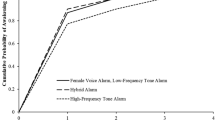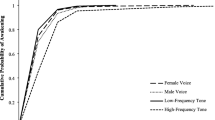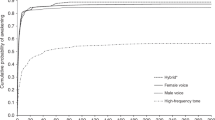Abstract
The results of over a decade of research at Victoria University on the effectiveness of various smoke alarm signals for awakening sleeping people are presented and compared. The results show that the signal level (sound volume, light intensity, etc.) and the type of sound or signal affect the probability of people being woken up by an alarm. The 520 Hz square wave sound was the most effective of the sounds tested, waking most (often all) of the participants. The smoke alarms currently used in Australia and the USA emit sounds of about 3,100 Hz. Many participants did not wake up to such tones even when very loud at the pillow (95 dBA). In all groups tested the high-pitched sound was the worst and in most, notably children, young adults (sober and 0.05 BAC) and older adults, it was much worse than the 520 Hz square wave signal. In adults with hearing loss it was more than seven times as effective as the current signal and more effective than the bed and pillow shakers. Strobe lights were found to have very poor waking effectiveness. A voice alarm was quite effective for younger age groups but not for older adults. The voice alarm was also found to have real problems in waking participants with limited English. It is recommended that the 520 Hz square wave sound in the T-3 pattern be adopted as a replacement for the current smoke alarm sound.










Similar content being viewed by others
References
AS 3786-1993, Smoke Alarms, Standards Australia, Sydney
NFPA 72 (2002) National fire alarm code. National Fire Protection Association, Quincy, MA
Thomas I, Ball M (2007) Consideration of domestic smoke alarms as a system, 10th suppression and detection research and applications conference (SUPDET2007). Retrieved 10th October 2007 from http://www.nfpa.org/assets/files//PDF/Proceedings/Consideration_of_Domestic_Smoke_Alarms_as_a_Sytsem_-_I.Thoma.pdf
Lee A (2005) The audibility of smoke alarms in residential homes, CPSC-ES-0503. US Consumer Product Safety Commission, Bethesda, MD. Retrieved 12th November 2007 from http://www.cpsc.gov/LIBRARY/FOIA/foia05/os/audibility.pdf
ABCB (2008) Building code of Australia volumes 1 and 2, Class 2. Australian Building Codes Board, Canberra
Ball M, Watts-Hampton T, Thomas I (2007) Domestic smoke alarms, which is best and how effective are they? A literature and statistics study. Centre for Environmental Safety and Risk Engineering, Victoria University, Melbourne, March (prepared for the Bushfire Cooperative Research Centre)
Peacock RD, Averill JD, Bukowski RW, Reneke PA. (2005) Home smoke alarm project, manufactured home tests. Retrieved 3/02/2006 from http://www.smokealarm.nist.gov/Series1.htm
Bruck D, Horasan M (1995) Non-arousal and non-action of normal sleepers in response to a smoke detector alarm. Fire Safety J 25:125–139
Bruck D (1998) Arousal from sleep with a smoke detector in children and adults technical report FCRC-TR 98-04. Fire Code Reform Centre, Sydney
Bruck D (1999) Non-awakening in children in response to a smoke detector alarm. Fire Safety J 32:369–376
Bruck D, Bliss RA (2000) Sleeping children and smoke alarms. In: Proceedings of the 4th Asia-Oceania symposium on fire science and technology. Asia-Oceania Association for Fire and Technology, Tokyo, pp 602–613
Bruck D, Brennan P (2001) Recognition of fire cues during sleep. In: Proceedings of the 2nd international symposium on human behaviour in fire. London, Interscience Communications, pp 241–252
Bruck D (2001) The who, what, where and why of waking to fire alarms: a review. Fire Safety J 36(7):623–639
Bruck D, Reid S, Kouzma J, Ball M (2004) The effectiveness of different alarms in waking sleeping children. In: Proceedings of the third human behaviour in fire conference. Belfast, 1–3 October, Interscience Communications, London, pp 279–290
Ball M, Bruck D (2004a) The effect of alcohol upon response to fire alarm signals in sleeping young adults. In: Shields J (ed.) In: Proceedings of the third human behaviour in fire conference. Belfast, 1–3 October, Interscience Communications, London, pp 291–302
Ball M, Bruck D (2004b) The salience of fire alarm signals for sleeping individuals: a novel approach to signal design. In: Shields J (ed) In: Proceedings of the third human behaviour in fire conference. Belfast, 1–3 October, Interscience Communications, London pp 303–314
Bruck D, Ball M (2005) Sleep and fire: who is at risk and can the risk be reduced? In: Proceedings of the 8th international symposium of the international association for fire safety science. Beijing
Bruck D, Thomas I (2006) Reducing fire deaths in older adults: investigation of auditory arousal with different alarm signals in sleeping older adults. Report for the Fire Protection Research Foundation. Retrieved 10th October 2007 from http://www.nfpa.org/assets/files//PDF/Research/Investigation_of_Auditory_Arousal.pdf
Bruck D, Thomas I (2007) Waking effectiveness of alarms (auditory, visual and tactile) for adults who are hard of hearing. Report for the Fire Protection Research Foundation. Retrieved 10th October 2007 from http://www.nfpa.org/assets/files//PDF/Research/hardofhearing&alarms.pdf
Bruck D, Thomas I, Ball M (2007) Waking effectiveness of alarms (auditory, visual and tactile) for the alcohol impaired. Report for the Fire Protection Research Foundation. Retrieved 10th October 2007 from http://www.nfpa.org/assets/files//PDF/Research/alcohol&alarmsreport.pdf
Bruck D, Thomas I (2007) A different smoke alarm signal will awaken many people more effectively. Sleep Biol Rhythms 5:A3
Ball M (2007) Cognitive processing during sleep: the role of signal significance and participant characteristics, PhD Thesis. Victoria University, Melbourne, Australia, Ch 6
Zepelin H, McDonald CC, Zammit GK (1984) The effects of age on auditory awakening. J Gerontol 39(3):294–300
Thomas IR, Verghese D (2001) CESARE-RISK: a summary report, Victoria University and Fire Code Reform Centre Ltd., Melbourne
Thomas IR, Brennan P (2002) Injuries and fatalities in apartment building fires. International association for fire safety science—proceedings of the seventh international symposium, pp 1085–1096
ISO 8201 (1987) Acoustics—Audible Emergency Evacuation Signal, International Standards Organisation, Geneva, Switzerland
Proulx G, Laroche C (2003) Recollection, identification and perceived urgency of the temporal-three evacuation signal. J Fire Prot Eng 13:67–82
Bruck D, Ball M (2007) Optimizing emergency awakening to audible smoke alarms: an update. Human Factors 49(4):585–601
Du Bois J, Ashley E, Klassen M, Roby R (2005) Waking effectiveness of audible, visual and vibratory emergency alarms on people of all hearing levels, In: Proceedings of the accessible emergency notification and communication: state of the science conference. Gallaudet University, Washington, DC, 2–3 Nov. Retrieved on 27th August 2006 from http://www.tap.gallaudet.edu/EmergencyConf/Papers/Du%20Bois.htm
Smith G, Splaingard M, Hayes J, Xiang H (2006) Comparison of a personalised parent voice smoke alarm with conventional residential tone smoke alarm for awakening children. Pediatrics 118:1623–1632
Bowman SK, Jamieson DG, Ogilvie RD (1995) Waking effectiveness of visual alerting signals. J Rehabil Res Dev 32:43–62
Hasofer AM, Bruck D (2004) Statistical analysis of response to fire cues. J Fire Safety 39:663–688
Cruickshanks KJ, Wiley T, Tweed T, Klein B, Klein R, Mares-Perlman JA et al (1998) Prevalence of hearing loss in older adults in Beaver Dam, Wisconsin: the epidemiology of hearing loss. Am J Epidemiol 148:879–886
Zwicker E, Flottorp G, Stevens SS (1957) Critical band widths in loudness summation. J Acoust Soc Am 29:548–557
Acknowledgement
These studies were financially supported by the Fire Protection Research Foundation, Australian Research Council, OneSteel and Umo Lai. Results in [15] are from the PhD research of Michelle Ball.
Author information
Authors and Affiliations
Corresponding author
Rights and permissions
About this article
Cite this article
Thomas, I., Bruck, D. Awakening of Sleeping People: A Decade of Research. Fire Technol 46, 743–761 (2010). https://doi.org/10.1007/s10694-008-0065-5
Received:
Accepted:
Published:
Issue Date:
DOI: https://doi.org/10.1007/s10694-008-0065-5




